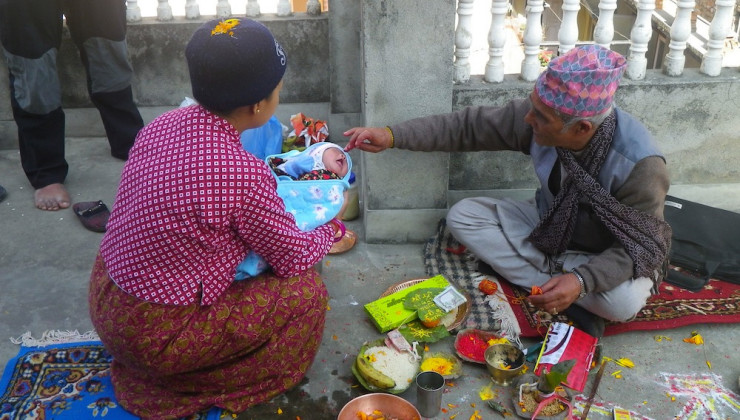Archive for the ‘Newars’ Category
A Nepal Breakfast on Roads & Kingdoms
in breakfast, daily life, Food, Newari Food, Roads & Kingdoms, writing
I’m delighted that a piece I wrote has been accepted by the super-awesome Roads & Kingdoms, one of my favourite sites. It’s a food/travel/etc website, and Anthony Bourdain is one of the people behind it, which gives you an idea of what kind of place it is.
My article is in the breakfast section, and you can read it here.
About the name-day event
in children, Food, Kathmandu, Newari Food, Newars
For the curious, here are a few more details about the photos in the last post, which I took on December 29th, when invited to the name-day ceremony for the new baby girl of a Newari family who are good friends of mine.
This event is held on the 9th day after a baby’s birth. While I can’t claim to understand all the nuances of the day, the simple explanation is that it is a religious ceremony performed by a Brahmin priest where the baby receives its auspicious religious name. This is not what the baby will actually be called, nor even her legal name, but is nonetheless a very important part of culture and society. You can see the name written in Sanskrit on the pipal leaf.
Also involved was lots of incense and ritual offerings of banana leaf bowls filled with flowers, rice, fruit and other foods, each laden with symbol and meaning.
At the end of it all, delicious celebratory Newari food. A young member of the family really, really wanted one of my peas!
A new baby girl, just nine days old
in children, Food, Kathmandu, Nepal, Newari Food, Newars
Fun and Food at a Newari Pasni
in children, Food, Nepal, Newari Food, Newars
Today I attended the pasni ceremony of the daughter of a family I’ve been friends with for years now. Pasni commemorates the first time a child is fed solid food–in this case, rice. It’s traditionally done for girls at 5 months of age and boys at 6 months. It begins with a visit to a local temple for a traditional blessing; when we arrived, the baby had just returned from this. We joined the family in the large bedroom; the baby on the double bed where her mother and grandmother sat, us with the rest of the family, on mats all around the room.
“What’s her name?”
“We haven’t decided yet,” answered her mother, to laughter from the room. She told us they’re currently using a nickname that rhymes with the names of two other female cousins.
The baby’s aunt began giving the traditional gifts, each one passed to the baby on a tray in turn (and removed by her mother): baby clothes, paper money, an orange. Similar gifts were given to other senior female relatives: a sari, bills, the orange. Jewelry was also put on the baby: a tiny golden ring which had been bought a size too small–again, everyone enjoys the humour–and a gold necklace and thick silver anklets.
Then, one by one, everyone puts a vermillion and rice tika on the baby, and then feed her a substance that resembled rice pudding; instead of a spoon, a solid gold coin is used to do this. She’s calm and zen, considering strangers are among those smearing her forehead and stuffing food in her mouth–for the first time, too!
Perhaps the most surprising thing about the whole affair is how warm and casual everyone is. There’s no sense of formality, of pretension; an ritual that goes back hundreds of years is underway, and while believed vital to the baby’s future, it’s performed with smiles, reminders, humour. And lots of camera flashes.
The ceremony is over sooner than expected, and as this is a Newari family, we are treated to a full spread of local eats. Newaris are the original inhabitants of the Kathmandu Valley, traditionally the caste of merchants and business people. Their culture, language, and food is completely unique within Nepal.
And their food is delicious.
Usually when I attend functions or visit friends’ homes, there are one or two dishes that are outstanding; at this meal, everything was:
An egg boiled, then fried was the first serving, with slabs of marinated meat and a bara, a small savory pancake; then another plate of more meat, soya beans, lightly spiced; a fantastic fresh cucumber and daikon pickle, both fried potatoes and yoghurt-turmeric spiced potatoes, a chicken curry. This yoghurt potato dish is from a small town in Gulmi, the ancestral home of this family; visiting their village is the only place I’ve ever eaten it. Now, the family makes it wherever they are. All of these dishes were bound together with beaten rice, commonly enjoyed with food at community functions.

This was taken before the yoghurt spiced potatoes and chicken curry arrived; I was too busy tucking in by then!
This was all washed down with small cups of raxsi, a local clear alcohol of unknown and varying strength were poured for us from the fine spout of a traditional brass jug, served with the first course, and throughout, long after we’d been sated.
When I asked if it was homemade, the reply was uniquely Nepali: “Yes, it’s homemade, but by somebody else!”





